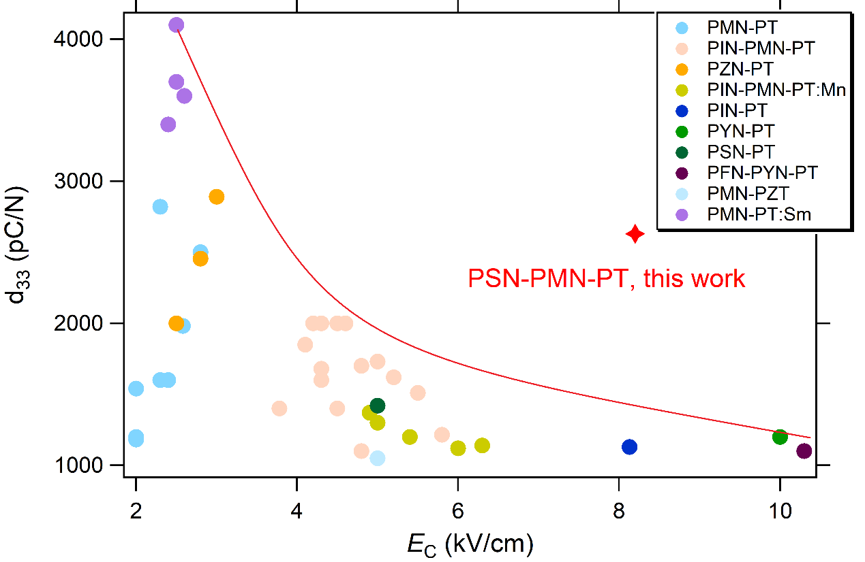Simultaneous giant piezoelectricity and ultrahigh coercive field in ferroelectrics - Dr. Gang Liu
MAY 5, 2022
High-drive electromechanical applications require ferroelectrics accounting for a large coercive field and high piezoelectricity simultaneously but it is still a challenge. Here, a team co-led by Dr. Gang Liu from HPSTAR performs a closely integrated experimental and computational investigations to solve this long-standing puzzle and demonstrate it in a relaxor-based ferroelectric crystal. Their results are published in recent issue of Nature Communications (Doi:10.1038/s41467-022-29962-6).
A large coercive field (EC) is essential for high-drive electromechanical applications, especially the case for greater power efficiency. The relaxor-PbTiO3 was firstly reported in 1980s, which has been a milestone for ultrahigh dielectric and piezoelectric properties in perovskite ferroelectrics and now has been extensively solicited to improve the performance of ferroelectric-related devices. However, due to the intrinsic correlation between phase transition and thermodynamic imbalance, the efforts of employing ultrahigh-piezoelectric crystals in high-drive devices encounter the challenge that high-piezoelectricity is generally accompanied by very low EC. The “puzzle” is that if there is a possibility to highly enhance the coercive field, and more importantly, without sacrificing their giant piezoelectricity.
By employing a largely anisotropic polar nano-regions (PNRs) doping strategy, novel ternary Pb(Sc1/2Nb1/2)O3-Pb(Mg1/3Nb2/3)O3-PbTiO3 crystals were well grown, demonstrating a large EC of 8.2 kV/cm and ultrahigh piezoelectricity (d33=2630 pC/N, d15=490 pC/N). The observed EC enhancement is the largest for ultrahigh-piezoelectric ferroelectrics, far exceeding any previously reported enhancements (see the Figure).
Then, a thermodynamic understanding of the strong correlation between free-energy landscape and superior materials properties is proposed, where a “flat and deep” potential well is necessary, then leading to a difficult polarization switch meanwhile an easy rotation. It offers a route to understand our observations in broader context.
“Up to now all doping routes in preparation of ferroelectric materials can be divided into two types: soft doping and hard doping, where the former is for high piezoelectricity while the latter aims at large EC. On the base of our results in this work, we propose a brand-new concept, “mild doping”, which can enhance two crucial performances simultaneously”, said Gang Liu, staff scientist of HPSTAR.
Although the relaxor–PT solid solution is employed herein, the proposed strategy in this work is likely a universal and effective method for designing high-performance functional materials with both high tolerance and sensitivity to the external field.
The collaborative research team also includes Prof. Limei Zheng and Dr. Liya Yang from Shandong University, Prof. Houbing Huang from Beijing Institute of Technology, Prof. Zengzhe Xi from Xi’an Technological University, Prof. Weiming Lv from University of Jinan, and Dr. Lingping Kong and Dr. Yonggang Wang from HPSTAR.

Caption: Dilemma in ferroelectrics: enhanced EC is usually achieved at the expense of piezoelectricity. The red line denotes the tendency of most giant-piezoelectric crystals. Generally, EC enhancement is accompanied by an inferior piezoelectricity. Alternatively, our 0.06PSN–0.61PMN–0.33PT (red star) affords highly remarkable results.
强矫顽场(EC)和巨压电性(d33)的铁电材料在高功率效率、小尺寸和轻重量的高驱动机电应用中至关重要。巨压电铁电材料的最新突破是PbTiO3基弛豫铁电晶体的发现。然而,其矫顽电场较低(通常只有2-3 kV/cm),极大程度限制了其应用。北京高压科学研究中心刘罡研究员与山东大学郑立梅教授、北京理工大学黄厚冰教授、济南大学吕伟明教授等单位合作,在一种新型铌钪酸铅-铌镁酸铅-钛酸铅弛豫铁电单晶中,通过局部的异质应力失配策略,实现了压电性能和矫顽电场的协同优化,创造了迄今为止,在巨压电材料中矫顽电场的最高记录。
